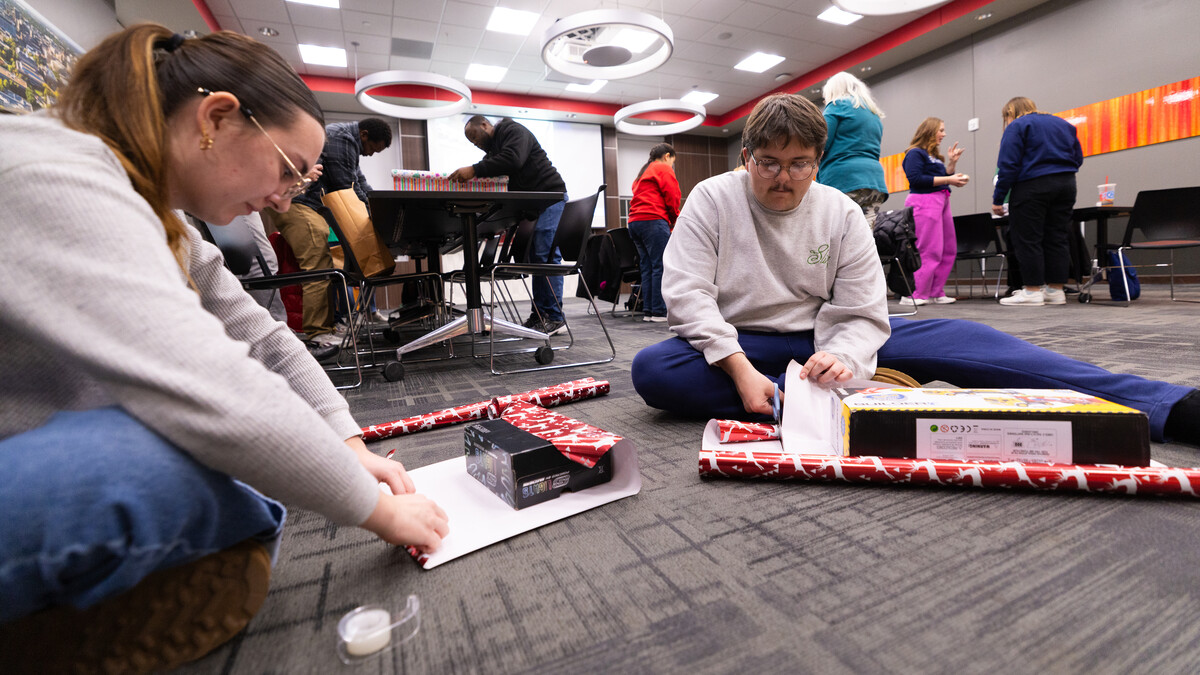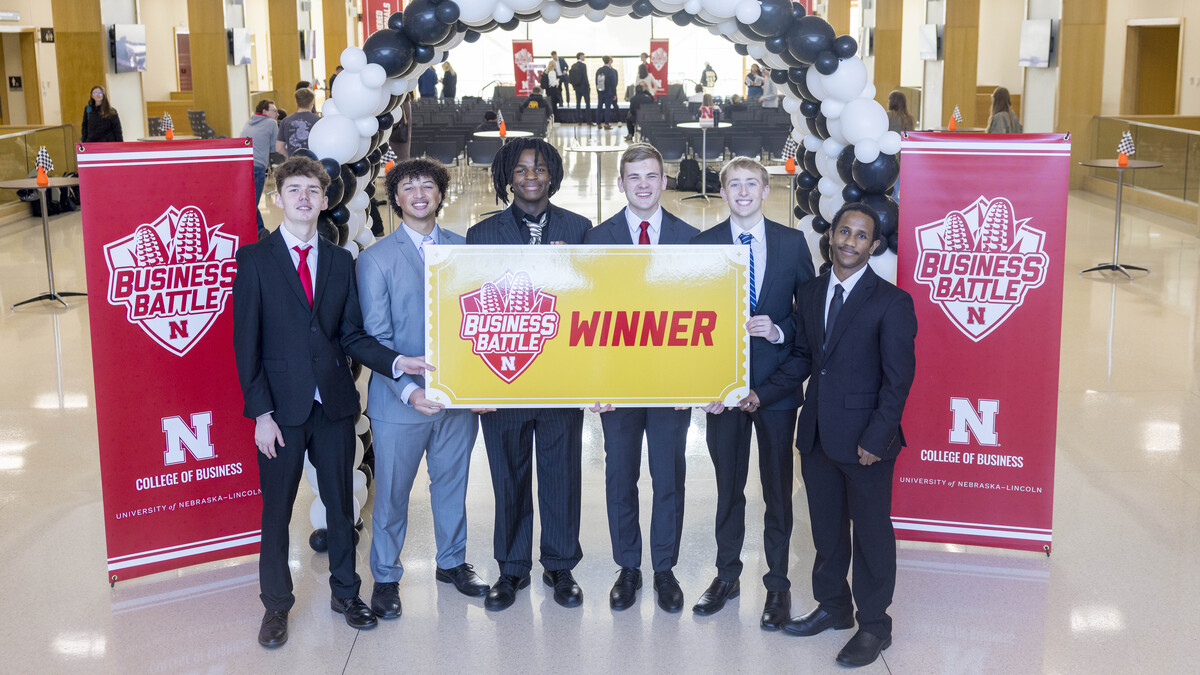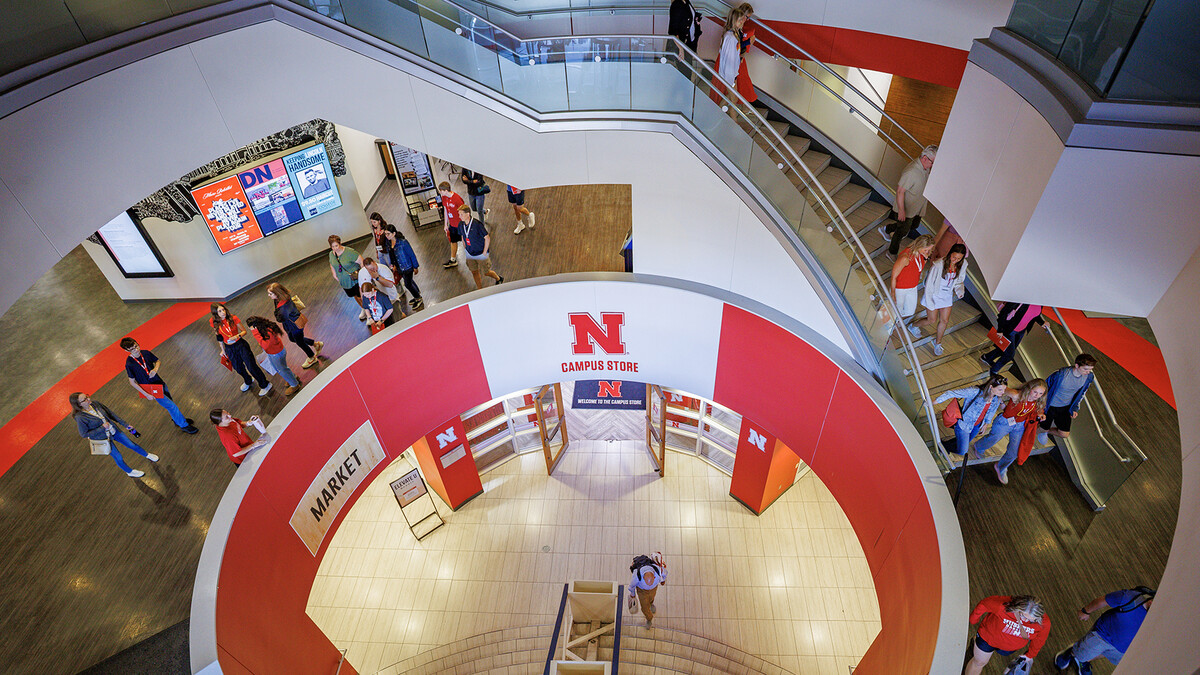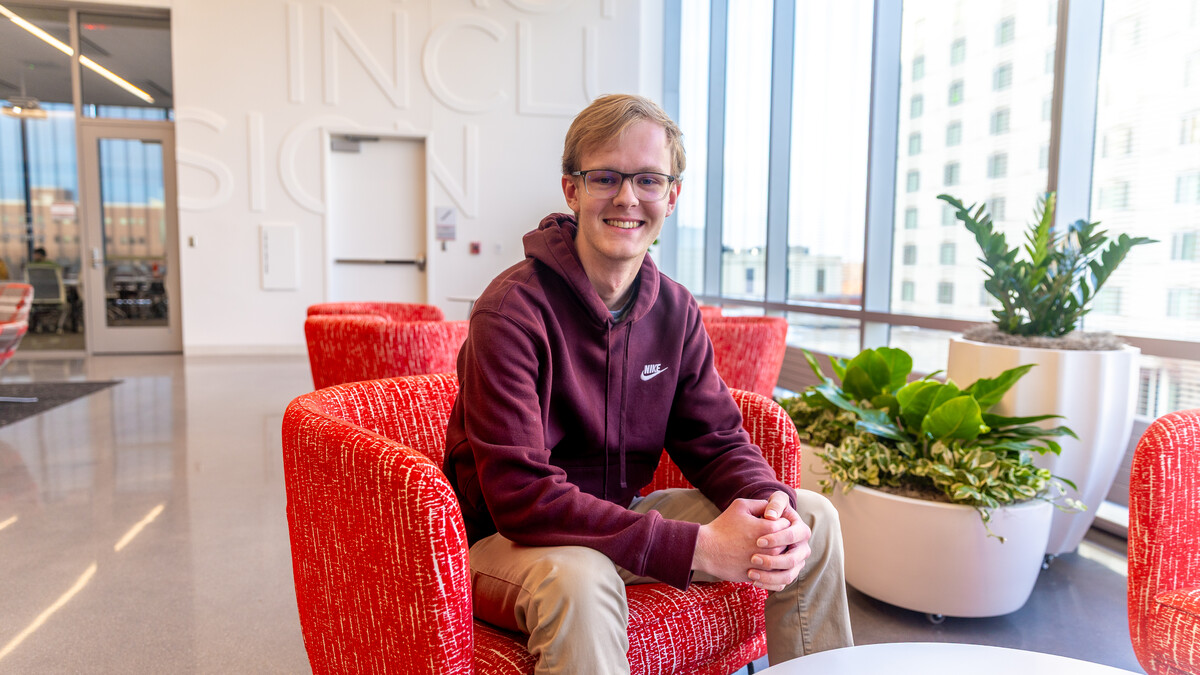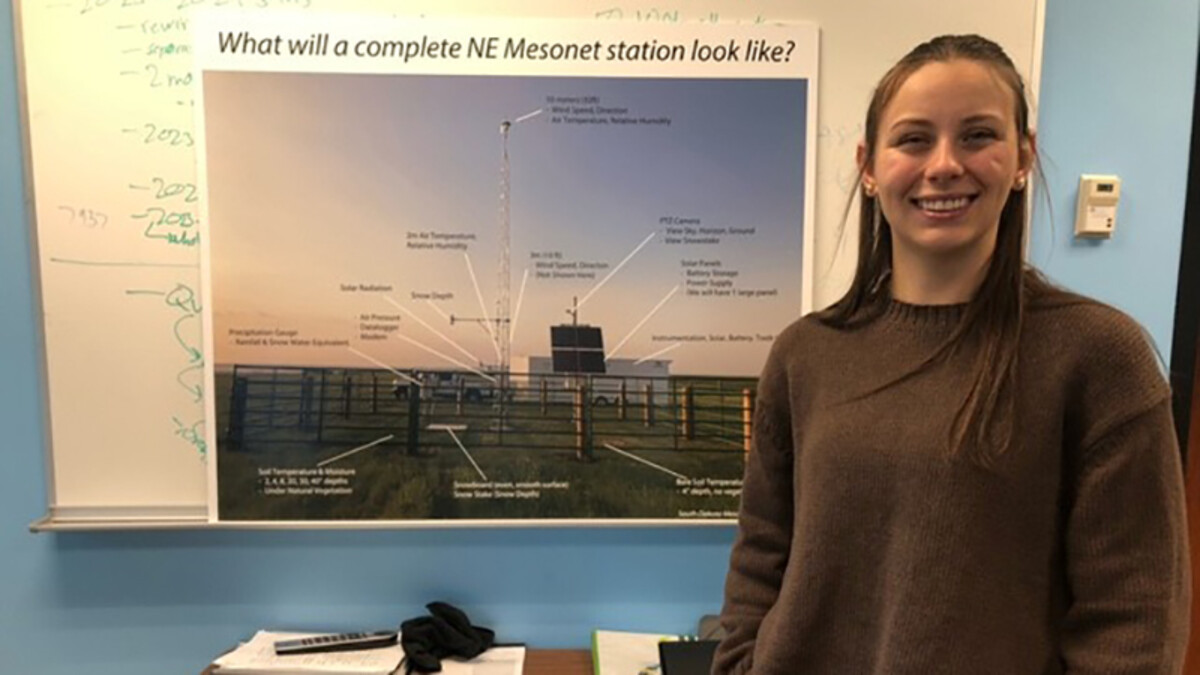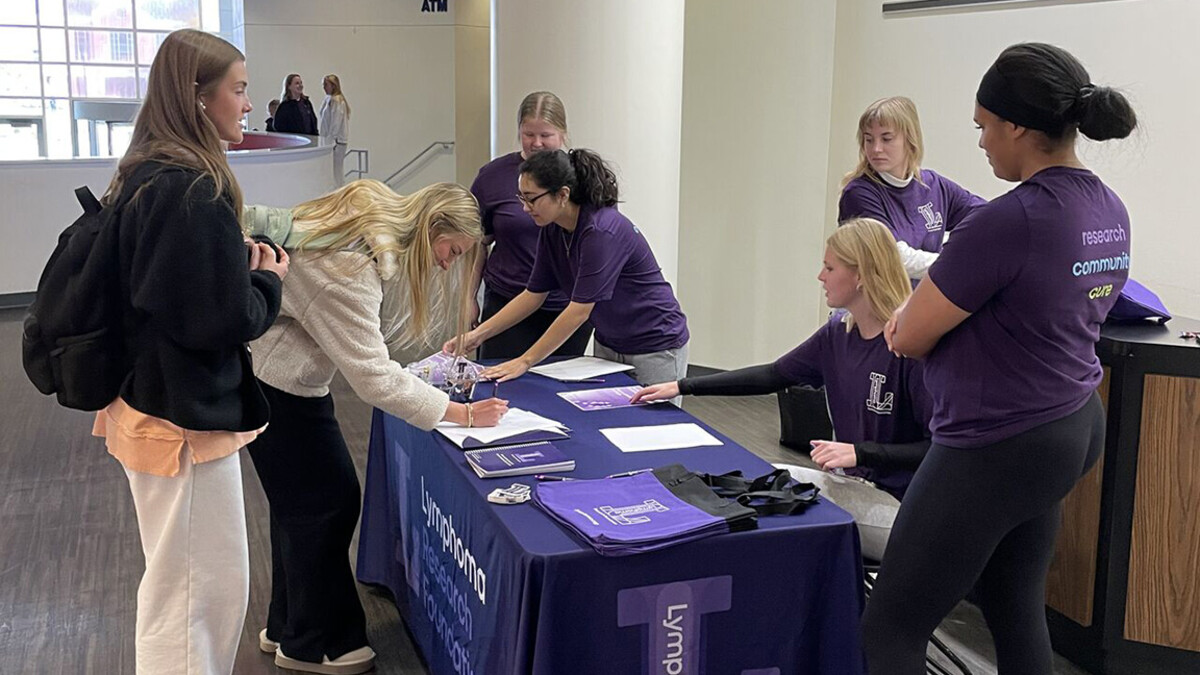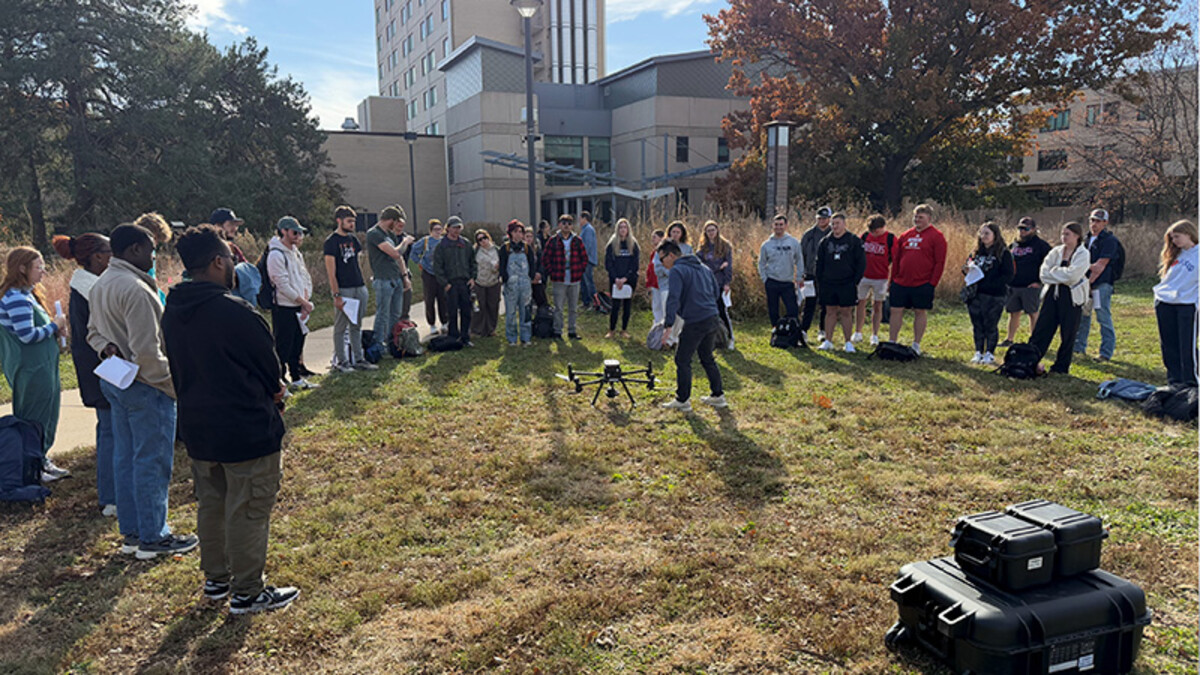
A pair of achievements by a father and son, a faculty member’s consultation on a Hollywood blockbuster and a series of first-of-their-kind crash tests generated national and international headlines for the University of Nebraska–Lincoln in 2024. More than 500 positive stories featuring the university, its faculty, staff, students, centers and programs appeared in national media outlets during the year.

- The spaceMIRA surgical robot, controlled by surgeons at Virtual Incision’s headquarters in Lincoln, performed a successful simulated procedure aboard the International Space Station on Feb. 10. The robot was invented by Shane Farritor, Lederer Professor of Engineering and co-founder and chief technology officer of Virtual Incision. Stories on the test appeared in at least seven Nebraska media outlets, CBC Kids News, CNN, The Independent, NBC News, NPR, Politico, Smithsonian Magazine, Space.com, The Washington Post and more than 600 other outlets.
- Also in February, Luke Farritor, a senior computer science major in the Jeffrey S. Raikes School of Computer Science and Management, was named a co-winner of the $700,000 Grand Prize in the Vesuvius Challenge. Farritor’s team — which also included Youssef Nader and Julian Schilliger — won the prize for deciphering at least four passages of text, each 140-plus characters long, from digital scans of a seared scroll. Stories on the accomplishment appeared in KOLN/KGIN, the Lincoln Journal Star, Omaha World-Herald, AOL, Bloomberg, Business Insider, CNN, The Independent, Live Science, Nature, NBC News, Scientific American, The Telegraph, Time, Vice, The Wall Street Journal and 1,500-plus other outlets.
- Adam Houston, professor of Earth and atmospheric sciences, was among scientists and weather experts consulted for the summer blockbuster “Twisters.” He is a principal investigator with Targeted Observation by Radars and UAS of Supercells (TORUS), a long-term research project that flies fixed-wing drones into storm clouds to gather data. Stories on Houston’s contributions appeared in at least six Nebraska media outlets, as well as the Daily Mail, Dronelife and Houston Chronicle.
- A series of electric vehicle crash tests conducted by the university’s Midwest Roadside Safety Facility was featured in numerous media outlets throughout the year. The groundbreaking tests suggest that current guardrails and traffic barriers are ill-equipped to handle electric vehicles, which tend to be heavier and have a lower center of gravity than their gas-powered counterparts. The crash test results were featured in at least eight Nebraska media outlets, ABC News, Accuweather, The Associated Press, Business Insider, CBS News, The Hill, KCTV, NBC News, Quartz, The Verge and 800-plus other outlets.

Inventors, innovators and trailblazers
- Peter Revesz, computing, deciphered an inscription on an ancient sphinx. He determined the message to be a proto-Hungarian poem written with Greek letters that reads: “Lo, behold, worship: here is the holy lion.” Stories on the discovery appeared in AOL, the Miami Herald, MSN, Yahoo! News and 30-plus other media outlets.
- Husker scientists and staff are formalizing existing research and outreach in precision agriculture into a strategic initiative called NFarms. The effort, in collaboration with producers and industry, will refine and expand precision ag capabilities crucial to boosting farm efficiency and environmental sustainability. Articles on the initiative appeared in Rural Radio Network, Farms.com and The Fence Post.
- A first-of-its-kind study from Liang Chen, Earth and atmospheric sciences, has projected decreases in both severe wind and extreme snowfall — the two elements that team up to produce blizzards. Stories on the research appeared in KGFW, KNOP, KOLN/KGIN, Rural Radio Network, the Des Moines Register, Newsweek and PreventionWeb.
- New research from a large survey study, co-authored by Husker political scientists Kevin Smith, Kyle Hull and Clarisse Warren, demonstrates the willingness of people to bend their morals — even behave unethically — when engaging in the political realm. Results also suggest that hostility toward outgroups is the driving factor for the moral ambiguity exercised when respondents switch from the personal to the political arena. The research was featured in Fast Company, PsyPost and Skeptic Society Magazine.
- Susan Sheridan, George Holmes University Professor of educational psychology and the founding director of the Nebraska Center for Research on Children, Youth, Families and Schools, was elected to the National Academy of Education in March. She is the first Husker faculty member selected for the honor. The Lincoln Journal Star and Nebraska Public Media published stories on the achievement.
- After two months of challenging field research in a northern Mississippi forest, Noori Choi has created a proof-of-concept for documenting the vibroscape: the ground-bound realm of vibrations that spiders, insects and an estimated quintillion other arthropods employ to court mates, hunt prey and escape predators. Choi was a doctoral student in biological sciences at Nebraska at the time of the research. Popular Science published an April 2 article on the research.
- Plant life first emerged on land about 550 million years ago, and an international research team co-led by Yanbin Yin, food science and technology, has cracked the genomic code of its humble beginnings, which made possible all other terrestrial life on Earth, including humans. Stories on the research appeared in KOLN/KGIN, Earth.com, Interesting Engineering and New Atlas.
- A novel study from the Center for Brain, Biology and Behavior at Nebraska and the University of Illinois at Urbana-Champaign has identified a specific nutrient profile in study participants who performed better cognitively. The profile is correlated with nutrients found in the Mediterranean diet, which research has previously associated with healthy brain aging. The research team was led by Aron Barbey, CB3 director, with Jisheng Wu, a doctoral student at Nebraska, and Christopher Zwilling, research scientist at UIUC. Stories on the study appeared in the Omaha World-Herald, BBC Science Focus, The Independent, Inverse, New Atlas, NBC’s “Today” and 150-plus other media outlets.

- Barney McCoy, broadcasting, was interviewed about his new documentary, “Running Towards the Fire,” for Straight Arrow News’ “Weapons and Warfare” program. The film, which was directed, produced and narrated by McCoy, captures the pivotal role war correspondents played during the Allied forces’ 1944 D-Day invasion of Europe and subsequent defeat of Nazi Germany and the Axis Powers in 1945.
- The College of Architecture opened the HDR Pavilion — named in honor of the college’s longstanding collaboration with the Omaha-based architecture/engineering firm — at the start of the fall semester. The pavilion, on the north side of Architecture Hall, features an expanded and renovated lecture hall, 14 new studio spaces, adjoining classrooms, and indoor and outdoor collaboration spaces. Architectural Record published a November article on the expansion.
- A Husker research team led by Kasia Glowacka, biochemistry, has identified a promising approach to help crops cope with drought. By using genome modification to boost a key plant protein, the researchers enabled plants to reduce their water use by up to 30% under drought-mimic conditions. Farms.com and The Fence Post ran articles on the research.
- Broadway World published a Sept. 4 article on “A House Divided,” a new play by Christina Kirk, which ran Sept. 17-22 at the Lied Center for Performing Arts. Based on real events, the play examines the choices faced by President Abraham Lincoln that threatened to unravel his family and the country during a week in 1863 when Mary Todd Lincoln’s half-sister, Emilie Todd Helm, visited the White House. Kirk is a professor of theatre at Nebraska.
- With a three-year, nearly $1 million grant from the National Science Foundation, James Schnable, agronomy and horticulture, will help develop the first digital twin of a corn field, enabling researchers to quickly test countless what-if scenarios related to corn performance. Stories on the research appeared in KETV, Nebraska Ag Connection, the Norfolk Daily News, Farms.com and The Fence Post.
- Husker researchers Seunghee Kim, civil and environmental engineering; Karrie Weber, biological sciences and Earth and atmospheric sciences; and Hyun-Seob Song, biological systems engineering and food science and technology, are studying the Midcontinent Rift — which runs from beneath Lake Superior through parts of Minnesota, Michigan, Wisconsin, Iowa, Nebraska and Kansas — to determine how best to access a potential store of natural hydrogen that could yield vast amounts of clean energy. Interesting Engineering ran an Oct. 17 article on the research.
- A team led by Galen Erickson, animal science, leader of the university’s Beef Innovation hub, has received a five-year, $5 million Grand Challenges grant from the university to better gauge the environmental impact of the ranching industry. The project will establish scientific processes and develop technology to accurately measure greenhouse gas emissions from grazing cattle. Stories on the project appeared in KHGI, Beef magazine and The Fence Post.

Trusted experts and recognized authorities
- With many media outlets focused on the November election, the university’s political science faculty were busy with interviews throughout the year. Popular topics included the possible importance of Nebraska’s 2nd District in the presidential race; the surprisingly tight U.S. Senate race in Nebraska between incumbent Deb Fischer and challenger Dan Osborn; the importance of Latino voters; civility (or the lack thereof) in modern politics; and how to cope with election stress. Faculty members Dona-Gene Barton, Pierce Ekstrom, John Hibbing (emeritus), Kevin Smith, Elizabeth Theiss-Morse and Sergio Wals were featured in ABC News, The Associated Press, Deseret News, the “FiveThirtyEight Politics Podcast,” The Guardian, The Hill (1, 2), The Independent, Inside Higher Ed, Midwest Newsroom, The National News Desk, Nature, The New York Times, Politico, Radio MD’s “HER” podcast, Reuters, the San Francisco Chronicle, the “Speaking of Psychology” podcast, Telemundo Nebraska, Time, USA Today (1, 2), U.S. News and World Report, The Wall Street Journal and Vox.
- Jack Beard, associate professor of law and director of the Space, Cyber and National Security Law Program, discussed the credibility of Russia’s space-based nuclear threats in several national news stories in 2024. “Given that so many critical military assets are now located in orbit, a strong argument could be made that the next world war between the superpowers is going to begin in space, particularly in the sense that the first shot is likely to be fired there,” he told Forbes in May. He was featured in The Washington Post (Feb. 16), Straight Arrow News (March 20) and a series of Forbes articles (April 16, May 23, June 28, July 31 and Oct. 28).
- Eve Brank, Aaron Douglas Professor of psychology and director of the Center on Children, Families and the Law, was interviewed by at least four national media outlets — Al Jazeera, BBC News, Reuters and WBUR’s “On Point” — on whether holding parents criminally responsible for their children’s actions could curb gun violence in the United States. She told BBC News that she thinks the emerging concept reflects broader frustration around U.S. gun violence and, in the absence of regulatory reform, the inability to curb the country’s firearms incidents. She told Reuters that it’s a tactic that could, at least in theory, extend to non-firearm cases. “A car in the hands of someone under the influence” could also be deadly, she said. “Continuing this trend could mean more opportunities to charge parents with a variety of offenses when their children commit crimes.”
- Kelli Boling, assistant professor of advertising and public relations, continued to be a sought-after source on the popularity and ethics of true crime media. She discussed the popularity of true crime podcasts among women for a Jan. 18 Daily Dot article, how true crime podcasts impact public interest in cases for an April 30 FOX News story and renewed interest in the case of Lyle and Erik Menendez caused by two recent documentaries for an Oct. 8 Rolling Stone article.
- Richard Graham, professor of University Libraries and courtesy professor of English, was featured in a Jan. 8 Fast Company article on government comic books. He has collected the unique comics since childhood and is the author of a collection titled “Government Issue: Comics for the People 1940s-2000s.” Graham recalled his father explaining the Army’s strategy of making comics to train the troops. “There’s a diversity of literacy rates (in the military) …” he said. “So the government learned early on that visual communication, coupled with an economy of text, is a good way to deliver a message.” Graham said his collection is still growing as new government comics are released, and he continues to learn about older ones.

A sampling of other university experts quoted in 2024:
- Humberto Blanco, agronomy and horticulture, April in Reuters, climate friendly farming strategies.
- Wesley Boyce, supply chain management and analytics, January in Straight Arrow News, possible economic impact of Houthi attacks on commercial ships in Red Sea.
- Kelsy Burke, sociology, January in The 19th and July in BBC, states passing age verification laws for people to access pornography online; February in NPR, popularity of online masturbation abstinence groups; March in The New York Times, coarsening of evangelical mores.
- Peter J. Capuano, English, February in USA Today, resurgence in popularity of “Frankenstein” movies.
- Joy Castro, English and ethnic studies, August on South Florida’s WLRN, first English-Spanish version of “Lagrimas y Flores,” a poetry collection written by her grandfather, Feliciano Castro.
- Kait Chapman, Nebraska Extension, May on CNN, proper tick removal and prevention.
- Byron Chaves, food science and technology, December on “Science Friday” podcast, food recalls.
- Bedross Der Matossian, history, September in The Christian Post and The Times of Israel, guest column on Armenia’s long history in the Holy Land.
- Dipti Dev, child, youth and family studies, October in Bored Panda, responsive feeding for children.
- Scott Gardner, biological sciences, curator of Manter Laboratory of Parasitology, May on CNN’s “OutFront with Erin Burnett and in The New York Times (1, 2) and Time, brain parasites.
- Gardner and Gábor Racz, collections manager of Manter Lab, July in Smithsonian Magazine, efforts to inspire students to become parasitologists.
- Hannah Guenther, Nebraska Extension, May on RFD-TV, nutritional benefits of beef.
- Heather Hallen-Adams, food science and technology, January in National Geographic, uncertain health benefits of mushroom supplements.
- Tomáš Helikar, biochemistry, March in Forbes Africa, growing use of “digital twins” in medicine.
- Danielle Jefferis, law, September in Christian Science Monitor, Nebraska officials pushing back against those who have completed felony sentences regaining right to vote; December in The Lever, infiltration of U.S. immigration detention system by private equity firms.
- Allison Johnson, biological sciences, August in ABC Australia, the splendid fairy-wren (Malurus splendens).
- Brandon J. Johnson, law, May in CBS News, how Donald Trump’s New York felony conviction could affect his ability to serve as president; October in The Associated Press, what happens if competing ballot measures pass.
- Jody Koenig Kellas, communication studies, March in Deseret News, potential of using family history to improve youth mental health.
- Leslie Klein, journalism, November in Education Week, challenges high school journalists face in covering politics.
- Lisa Kort-Butler, sociology, April in Big Think, perceptions of crime in United States.
- Kate Lyons, biological sciences, June in Science, study suggesting that climate change and human hunting caused extinction of woolly rhinoceros; July in Phys.org, study she co-authored with doctoral graduate Alex Shupinski tracking changes to mammalian ecosystems and species diversity on North American continent.
- Laura K. Muñoz, history and ethnic studies, August on Phoenix’s KJZZ, how best to teach English to bilingual students.
- Larkin Powell, School of Natural Resources, November in Harvest Public Media, ongoing research he has led on how drought affects painted turtles.
- Sheila Purdum, animal science, March in Business Insider, grocery store eggshells seeming to chip easier.
- Mario Scalora, University of Nebraska Public Policy Center, September in Christian Science Monitor, school districts’ efforts to prevent school shootings; September on RFD-TV’s “Rural Health Matters,” his work with federal, state and local agencies on threat management and counterterrorism issues.
- Jessica A. Shoemaker, law, July on Ambrook Research’s “The Only Things That Last” podcast, how system of allotment attempted to erase communal resources and assimilate Indigenous communities in 1880s.
- Todd Thornock, accountancy, October in The Conversation, co-written opinion piece on strategies for giving effective performance reviews.
- Lily Wang, architectural engineering and construction, June in The Washington Post, noise levels in restaurants.
- Robert Woody, music, January, May, August and December in Psychology Today, blog posts on self-compassion, the psychophysiology of stage fright, “dry spells” in composing, and performance anxiety in children.
- Yiqi Yang, textiles, merchandising and fashion design and biological systems engineering, June in The Washington Post, whether linen or cotton keeps one cooler in summer heat.
University Communication tracks faculty, administration, student and staff appearances in the national media and reports upon them month by month. If you have additions to this list, contact Sean Hagewood, news coordinator, at shagewood2@unl.edu or 402-472-8514. If you have suggestions for national news stories, contact Leslie Reed, public affairs director, at lreed5@unl.edu or 402-472-2059.
